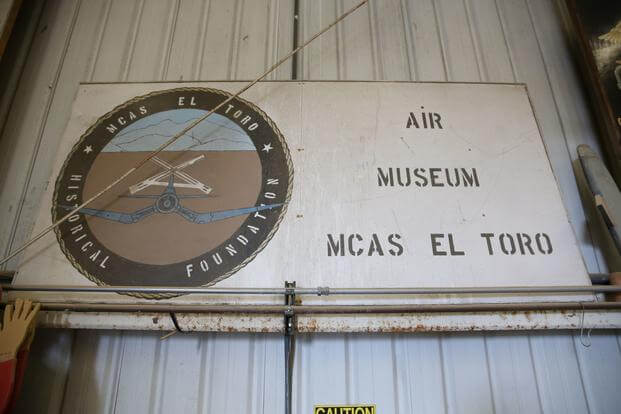The Marine Corps will permanently close its only museum devoted solely to aviation on March 28 -- a decision the institution's foundation and volunteers have worked for the past decade to avoid.
The Flying Leatherneck Aviation Museum, aboard Marine Corps Air Station Miramar in San Diego, attracts more than 35,000 visitors each year. Its collection of 48 aircraft includes the CH-46E Sea Knight that evacuated the U.S. ambassador from the roof of the American Embassy in Saigon in 1975, an OV-10 Bronco observation plane and a World War II PBJ-IJ medium bomber.
The museum is run jointly by the Marine Corps and the Flying Leatherneck Historical Foundation. But in an era of tight budgets, the service determined it can no longer contribute the $460,000 it has provided annually to pay five employees and cover the costs of maintenance and utilities.
Read Next: 'In a Very Difficult Environment,' Coast Guard Offers Incentives to Entice Troops
Miramar commander Col. Charles Dockery made the decision to close the museum earlier this year, according to Capt. Matthew Gregory, director of communications for the base.
"The $460,000 is not a one-time purchase but a year-over-year cost that now equates upward of $8 million in monies over the last two decades," Gregory said. "This is just the amount necessary to maintain the status quo, including facilities that are well beyond their service life. And unfortunately, the status quo is not acceptable for the long term."
In addition to housing and restoring aircraft, the Flying Leatherneck Aviation Museum holds more than 30,000 artifacts, including aviation art and equipment.
But according to retired Brig. Gen. Michael Aguilar, president of the foundation, the facility is more than a collection of relics; it attracts school field trips, serves as an event venue -- provided at no cost -- to veterans organizations and community groups, and is a popular destination for Marine Corps recruiters to bring poolees.
"This free museum is an important part of a strong community outreach program. That's now going to be lost," Aguilar said.
The museum was founded in 1989 on the former Marine Corps Air Station El Toro as the Jay W. Hubbard Aviation Museum. Until 2003, much of the cost for running it was covered by non-appropriated funds -- money raised from sources other than federal appropriations, mainly sales and services at military exchanges and recreational facilities.
But that year, a decision was made that NAF accounts couldn't be used to operate the museum, and it fell to the base's operations department. From 2008 to 2017, the foundation and the Corps went back and forth on proposals to construct a new building and plans for the foundation to take over the museum's operations and financing.
Last year, the House version of the fiscal 2021 National Defense Authorization Act carried a provision that would have allowed the foundation to assume a no-cost lease for the land the museum currently occupies. But the Senate bill did not contain the measure, and it never became law.
Under federal law, the foundation must pay fair market value to lease the acreage if it wants to assume operations and management -- "a substantial and recurring amount [the foundation has] acknowledged would be beyond their ability to fund," Gregory said.
Gregory said the Marine Corps will not immediately recoup the annual funding because the employees will need to stay on for a few years to manage the relocation or disposal of the museum's artifacts.
He said two museums are primarily responsible for the artifacts -- the National Museum of the Marine Corps in Quantico, Virginia, and the National Navy Aviation Museum in Pensacola, Florida. But other museums have expressed interest in acquiring several aircraft, including the U.S.S. Midway Museum in San Diego, the San Diego Air and Space Museum, and the Pima Air Museum in Tucson, Arizona.
"We firmly believe that working with these organizations and museums around the country will help get the aircraft to people who might otherwise not travel to Miramar or even San Diego," Gregory said.
Aguilar said he understands Dockery's decision but added that his organization is still working to come up with a solution to save the museum.
"We all understand that the priority is to take care of the warfighter. We get that. We are really trying to continue to work with him and the Marine Corps to come up with a solution that is a win-win for the Corps and the museum," he said.
David Zekert, volunteer coordinator at the museum, said he hopes the foundation can reach an agreement with the Corps because he believes the facility, which helps connect former service members and their aircraft to members of the community, is invaluable.
"It gets people inspired a little bit, a little bit of that feeling of being American, you know -- the red, white and blue. I don't see that happen very much anymore," Zekert said.
The Flying Leatherneck Aviation Museum is one of three command museums in the Corps; the others are at Marine Corps Recruit Depot San Diego, California, and MCRD Parris Island, South Carolina.
The National Museum of the Marine Corps is a joint effort between the Corps and the Marine Corps Heritage Foundation. It falls under the command of Marine Corps University.
-- Patricia Kime can be reached at Patricia.Kime@Monster.com. Follow her on Twitter @patriciakime
Related: The National Museum of the Army Finally Has an Opening Date














